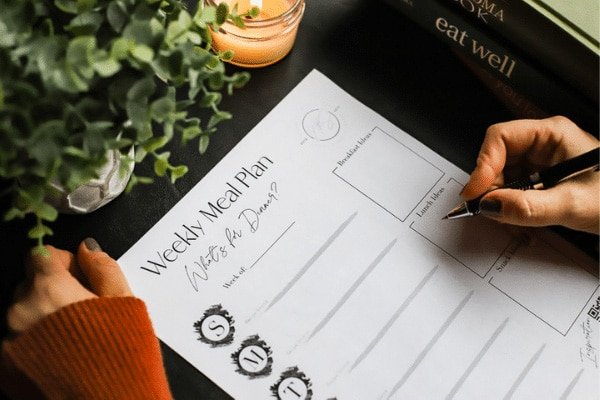You’re making your favorite cozy soup on a rainy day (arguably the best kind of soup day, right?), and the recipe calls for beef broth. What if, instead of reaching for a pricey store-bought carton, you grabbed a jar of your own homemade beef broth from the pantry? That’s pretty much been my dream since I got my canner.
Not only will it save you a ton of money over time, but you’ll also skip the preservatives and additives so often included in store bought options, and extra packaging that come with so many store-bought versions (I’m looking at you caramel color- you’d be surprised how many broths it is included in). Plus, there’s just something satisfying about popping open a glass mason jar filled with broth you made yourself.
Now, I know what you might be thinking—canning beef broth sounds like a whole thing. Is it really worth the effort?
The short answer: yes, absolutely! Whether you’re trying to make more health-conscious food choices or just looking to stretch your grocery budget a little further, learning to can your own beef broth is a total win.
Canning might feel a little intimidating at first, I know it was to me, but it really just comes down to following a simple process. So I’m walking you through it step-by-step—starting with my go-to homemade beef broth recipe—so you’ll be ready when soup season rolls around again (or, you know, any random rainy Tuesday).
What is Canning Beef Broth?
Canning beef broth is really just a fancy way of saying you’re making your own broth at home, usually by simmering beef bones with veggies and water, and then preserving it in glass jars so it stays fresh without needing fridge or freezer space.
To keep it safe and shelf-stable, you’ll use a pressure canner. (I recommend the All-American Pressure Canner) It gets hot enough to kill off any bacteria and make sure your broth is safe to store long-term.
It’s such a smart way to always have rich, homemade broth on hand for soups, stews, and cozy meals, especially when you want something nourishing and budget-friendly.
Can You Can Beef Broth?
Yes, you can absolutely can beef broth, but it’s super important to do it the right way. Because beef broth is a low-acid food, it can be more likely to grow harmful bacteria (like Clostridium botulinum—yikes!), which is why using a proper pressure canner is non-negotiable. It’s what makes the broth shelf-stable and totally safe to store.
And the best part? You can make a big ol’ batch in one go and stock your pantry with jars of rich, homemade broth that’ll last you the whole year. Perfect for soups, stews, sauces—you name it. Once you start doing it yourself, you’ll wonder why you didn’t start sooner!
Does Canned Beef Broth Go Bad?
When canned and sealed properly, homemade canned beef broth can stay good for 12 to 18 months—pretty amazing, right? Just be sure to store your jars in a cool, dark, and dry spot like a pantry or basement shelf.
After that time, if the seal is still intact, it might still be safe to use, but just know the flavor and nutritional punch may start to fade a bit.
Now, if you ever notice a jar with a popped lid, bulging top, odd smell, or cloudy broth, it’s best to skip it. When it comes to home-canned goods, the rule of thumb is simple: when in doubt, toss it out. Better safe than sorry!
How to Can Beef Broth
Ingredients
- 6-8 lbs of beef bones (marrow bones, knuckle bones, oxtails, short ribs)
- 2-3 carrots, chopped
- 2-3 celery stalks, chopped
- 2 onions, quartered (leave skins on for rich color)
- 1-2 bay leaves
- 6-8 peppercorns
- 1-2 tbsp apple cider vinegar (helps extract minerals from bones)
- Water to cover (around 8-10 quarts)
- Optional: garlic cloves, fresh thyme, parsley stems
Equipment
- Pressure Canner (not a pressure cooker!)
- Canning jars (pint or quart jars), lids, and rings
- Jar lifter
- Funnel
- Ladle
- Clean cloths or paper towels
- Vinegar (to wipe rims and reduce mineral spots)
Instructions
Step 1: Prepare the broth.
Start by preheating your oven to 425°F. Place your beef bones in a single layer on a baking sheet and roast them for about 45 to 60 minutes, until they’re nice and browned (that’s where all the deep, delicious flavor comes from!). Toss in your chopped veggies during the last 20 minutes to get them roasty and golden, too.
Next, transfer the bones and veggies to a large stockpot or slow cooker. Cover with water (I use water from our Cloud RO Water Filtration Unit), leaving 2-3 inches at the top, and add a splash of apple cider vinegar along with your favorite herbs and spices. Bring it all to a gentle boil, then lower the heat to a bare simmer.
Now, here’s the part that takes a little patience—let it simmer uncovered (or partially covered) for 12 to 24 hours. The longer it goes, the richer your broth will be. I like to give it a little skim every so often (every 40 to 60 minutes or so) to remove any foam or gunk that floats to the top. And if the water level drops too low, just top it off to keep those bones fully covered.
When you’re done, pour the broth through a fine mesh strainer into a clean pot or large bowl. Toss the bones and veggies (or compost them if you’re into that!), and let the broth cool a bit before moving on to canning and storing.
Step 2: Sterilize jars and prep the lids.
You’ll want to make sure your jars and lids are nice and clean and ready to go. Start by washing the jars, lids, and rings in hot, soapy water, then give them a good rinse.
Next, place the jars upside down on a baking sheet and pop them into a 200°F oven for about 15-20 minutes. This helps warm them up so they don’t crack when the hot broth goes in (because nobody wants that kind of mess).
While the jars are heating, simmer your lids in a small pot of water—not boiling, just a gentle simmer. This softens the seals and helps ensure a nice, tight fit when it’s time to close things up.
Step 3: Reheat your broth.
Go ahead and pour your cooled broth into a large pot and bring it to a boil on the stove. You’ll want it nice and hot when you’re filling your jars, so keep it simmering while you work.
A little tip? Start reheating the broth while your jars are warming in the oven—that way, everything’s ready at the same time and you’re not waiting around. Multitasking for the win!
Step 4: Fill the jars.
Using a funnel (it makes life so much easier), carefully ladle the hot broth into your hot jars, leaving about an inch of space at the top—that’s your “headspace.”
Next, gently run a bubble remover or a clean spatula around the inside edge to release any trapped air bubbles. Then grab a cloth dampened with a little vinegar and wipe the rims clean—this helps make sure you get a solid, clean seal when you add the lids.
Add the center lids on the jar and screw the bands on the jars. Make sure they’re just fingertip-tight, not too tight.
Step 5: Load jars into the pressure canner.
Carefully place your filled jars on the rack inside your pressure canner, then pour about 2-3 inches of water (just enough to create steam, not cover the jars).
Secure the lid, but keep the vent open for now. Crank up the heat to high and let it do its thing until you see a steady stream of steam coming out for at least 10 minutes. You’re almost there!
Step 6: Pressurize the jars.
Once that steady steam has been going for about 10 minutes, go ahead and close the vent and add the weight—just follow the directions for your type of pressure canner.
If you’re using a weighted gauge pressure canner, you’ll want 10 pounds of pressure. If you’ve got a dial gauge, aim for 11 pounds.
Now for the processing time:
- Pint Jars – 20 minutes
- Quart Jars – 25 minutes
Then let the canner work its magic while you check “homemade beef bone broth” off your to-do list!
Step 7: Cool the pressure canner.
Once your timer’s up, turn off the heat and let the pressure in the canner come down naturally to zero—don’t rush it! This part is important for safety (and for keeping those jars sealed tightly).
When the pressure has fully dropped, wait another 10-15 minutes just to be extra safe. Then, carefully remove the lid—always opening it away from your face. That steam is no joke!
Step 8: Remove the jars and cool them.
Using a jar lifter (or very carefully with oven mitts), transfer your hot jars to a towel-lined counter. Be sure to leave a little space between them so they can cool properly.
Now the hard part: don’t touch! Let them sit undisturbed for 12 to 24 hours while they cool and seal. It’s the perfect time to clean up the kitchen—or just put your feet up and enjoy that satisfying ping sound as the lids seal.
Step 9: Check the seals.
Once your jars have cooled completely, give the lids a light press in the center. If they don’t pop up or down, you’ve got a good seal—yay!
Next, remove the rings, wipe down the jars to clean up any residue, and don’t forget to label them with the contents and the date. Trust me, your future self will thank you when you’re digging through the pantry later!
How Long Can You Store Canned Beef Broth in the Fridge?
Once you pop open a jar of your home-canned beef broth, go ahead and stash it in the fridge, and try to use it within 4 to 5 days.
Not planning to use the rest right away? No problem! Just pour it into ice cube trays, silicone molds, or a freezer-safe container and tuck it into the freezer. It’ll keep beautifully for up to six months—and you’ll love having those flavor-packed cubes on hand next time soup season rolls around!
Is it intimidating at first? Yes. But let this be your sign to give it a try and start making canned beef bone broth at home and stock up all year long!
Canning your own homemade beef broth is seriously one of the best kitchen moves you can make. Not only does it stretch your grocery budget, but you also get a rich, flavorful broth—without any of the mystery ingredients. And the best part? It’ll keep for up to 18 months on the shelf. Total win.
If you’re on a broth-making roll (I get it, it’s addictive in the best way), be sure to check out my other broth recipes too. And don’t forget, you can always circle back to this post when you’re ready to can your next batch!



Leave a Comment